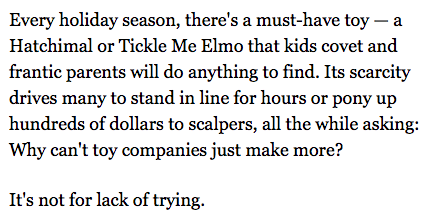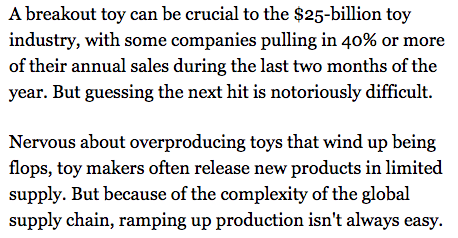Static Games from a Player's Perspective
Christopher Makler
Stanford University Department of Economics
Econ 51: Lecture 8
Reminder: Notation
Today's Agenda
Dominant and Dominated Strategies
Best Responses
Rationalizability and
Iterated Deletion of Dominated Strategies
Application: Cournot Model
Dominance
One strategy strictly dominates another strategy
if it always yields a strictly higher payoff
no matter what the other players do.
A pure strategy is dominated for a player if
there’s some other strategy that that player could choose
which would give them a higher payoff
no matter what the other players are doing.
One strategy weakly dominates another strategy
if it never yields a strictly lower payoff
no matter what the other players do,
and sometimes yields a strictly higher payoff.
Right weakly dominates Left.
Top strictly dominates Bottom.
1
2
Top
Bottom
Left
Right
2
5
,
1
0
,
4
1
,
5
5
,
pollev.com/chrismakler

Which strategies are dominated?


pollev.com/chrismakler

Which strategies are dominated?


pollev.com/chrismakler

Which strategies are dominated?
1
2
0
0
,
1
1
,
1
1
,
4
4
,
U
M
L
R
D
4
4
,
0
0
,
How to search for a dominated strategy:
1. Look to see if it's dominated by another pure strategy
2. Look for candidate mixed strategies, especially different strategies with alternating large payoffs
3. Remember: you only need to find one strategy that dominates a strategy for strategy to be dominated.
pollev.com/chrismakler

Suppose you were playing this (symmetric) game as either player. What would you choose?
1
2
C
D
C
D
2
2
,
3
0
,
1
1
,
0
3
,
- Players: prisoners being interrogated in separate rooms.
- Strategies: "cooperate" (don't rat out other)
or "defect" (squeal like the little rat you are) -
Payoffs:
- If they both cooperate, the prosecutor doesn't have much to go on, so they each get a light sentence.
- If they defect while the other cooperates, they go free.
- If they both defect, they both go to jail for a long time.
Prisoners' Dilemma
1
2
Cooperate
Defect
Cooperate
Defect
If you believe the other person will defect,
what is your best response?
If you believe the other person will cooperate, what is your best response?
Defect
Defect
2
2
,
3
0
,
1
1
,
0
3
,
Prisoners' Dilemma
1
2
Cooperate
Defect
Cooperate
Defect
If you believe the other person will defect,
what is your best response?
If you believe the other person will cooperate, what is your best response?
Defect
Defect
Because Defect aways results in a
strictly higher payoff than Cooperate, we say that
Defect strictly dominates Cooperate.
2
2
,
3
0
,
1
1
,
0
3
,
Prisoners' Dilemma
1
2
Cooperate
Defect
Cooperate
Defect
2
2
,
3
0
,
1
1
,
0
3
,
(C,C) pareto dominates (D,D)
(D,D) is a dominant strategy equilibrium
The First Strategic Dilemma:
Everyone doing what's best for themselves can lead to a group loss.



The First Strategic Tension:
Everyone doing what's best for themselves can lead to a group loss.
Domination vs. Best Response
-
Dominated strategy: some other strategy is better
no matter what you believe the other players will do -
Best response: the best strategy (or strategies) to play
given specific beliefs about what the other players will do
Definition: Best Response
In plain English: given my beliefs about what the other player(s) are doing, a strategy is my "best response"
if there is no other strategy available to me
that would give me a higher payoff.
Golden Balls
Split
Split
Nick
Ibrahim
Steal
Steal
6,800
6,800
13,600
0
0
13,600
0
0
In this one-shot game, what is the best response to the belief that the other person is playing Steal?
pollev.com/chrismakler

1
2
1
2
,
4
3
,
1
4
,
1
1
,
Top
Middle
Left
Center
Bottom
Right
3
0
,
2
1
,
3
2
,
8
0
,
8
0
,
How should player 1 best respond to a belief that player 2 will play Left? What about Center or Right?
Believe Left => play Middle
Believe Center => play Bottom
Believe Right => play Top or Bottom
1
2
1
2
,
4
3
,
1
4
,
1
1
,
Top
Middle
Left
Center
Bottom
Right
3
0
,
2
1
,
3
2
,
8
0
,
8
0
,
How should player 1 best respond to a belief that player 2 will play
Left with probability 1/2, and Center and Right with Probability 1/4 each?
Player 1's expected payoffs given \(\theta = ({1 \over 2}, {1 \over 4}, {1 \over 4})\)
What is player 1's best response if they believe player 2 will play L?
What is player 1's best response if they believe player 2 will play R?
What is player 1's best response if they believe player 2 will play
L or R with equal probability?
1
2
0
0
,
1
1
,
1
1
,
4
4
,
U
M
L
R
D
4
4
,
0
0
,
What is player 1's best response if they believe player 2 will play L with probability q,
and R with probability 1 - q?
1
2
0
0
,
1
1
,
1
1
,
4
4
,
U
M
L
R
D
4
4
,
0
0
,
PLAYER 1'S BELIEFS
1
2
0
0
,
1
1
,
1
1
,
4
4
,
U
M
L
R
D
4
4
,
0
0
,
PLAYER 1'S BELIEFS
- There is no belief about what Player 2 might do for which M is a best response.
- Remember: M was also dominated by a mixed strategy over {U, D}.
- Result: in a finite two-player game, the set of strategies which are never a best response for any belief is also the set of dominated strategies.
Application: Oligopoly
Applications of Game Theory:
Strategic Interactions between Small Numbers of Agents
- Very realistic - lots of examples, from families to international diplomacy
- Models of oligopoly
- 1838: Cournot
- 1883: Bertrand
- 1929: Hotelling
- 1934: Stackelberg
- Mid-20th century: John Nash formalized and generalized the notion of strategic equilibrium among small numbers of agents
Competition
- Lots of "small" firms selling basically the same thing (commodity goods)
Oligopoly
- A few "medium" or "large" firms selling differentiated products
- Firms face essentially horizontal demand curve
- Firms face downward sloping demand curve
-
Interdependence:
each firm's choice
affects other firms
-
Independence:
no individual firm's choice affects other firms



Cournot Duopoly
- Two firms ("duo" in duopoly)
- Each chooses how much to produce (quantity competition)
- Market price depends on the total amount produced
- Each firm faces a residual demand curve
based on the other firm's choice



Simple case: linear demand, constant MC, no fixed costs
What is firm 2's best response function?
2
P
"Firm 2's Residual Demand Curve"
Firm 2's "best response function"
Firm 2's "best response function"
Conclusions and Next Steps
Today we've looked at games from the perspective of a player:
what is my best response to what everyone else is doing?
Next time: look for Nash Equilibrium
in which everyone is best responding to everyone else.
Econ 51 | 08 | Dominance, Best Response, and Rationalizability
By Chris Makler
Econ 51 | 08 | Dominance, Best Response, and Rationalizability
The first steps to understanding strategic behavior: what will you NOT do? What, based on your beliefs about the other players' strategies, might you do?
- 858



